
Shared posts
Watch The Entire First Episode Of Joseph Gordon Levitt’s New Show HitRecord On TV
This doesn’t actually premiere on TV until Saturday, Jan. 18, on Pivot at 10 p.m., but you can now watch the entire first episode of Joseph Gordon Levitt’s new TV show, HITRECORD ON TV, an extension of his open collaborative production company started in 2005.
I watched this entire thing and while it’s enjoyable and cute, has high production values and really celebrates the spirit of collaboration in the arts (a spirit well served by the episode’s theme: the number one), I’m really not sure if there will be an audience for this kind of thing on an ongoing basis outside of the artists who appear on the show themselves. Though, granted, there seem to be plenty of them. More than anything, this seems like great motivation to get more people involved with HitRecord.
Also, the first little short film starring Elle Fanning is darling.
Click here to view the embedded video.
Watch The Entire First Episode Of Joseph Gordon Levitt’s New Show HitRecord On TV
Laugh-Out-Loud Funny Muppets TV Spot Skewers The Trend For Quoting Twitter In Trailers
The Muppets had a fantastic trailer campaign. The Muppets Most Wanted… not so much. Until today. They just upped their game in a big, big way.
Click here to view the embedded video.
Muppets Most Wanted is out on March 21st in the US, 28th in the UK.
Laugh-Out-Loud Funny Muppets TV Spot Skewers The Trend For Quoting Twitter In Trailers
Talented Women Join Forces To Help Lady Characters Fight Yetis In Lumberjanes Comic
Yesterday I heard the name Lumberjanes. And I don’t think I’ll ever forget it.
Comics Alliance has the info and preview pages of Lumberjanes, a new series being written by Noelle Stevenson and Grace Ellis, with art by Brooke Allen for Boom Box! It was created by Ellis and Boom! Senior Editor Shannon Watters. Boom Box! is a relatively new imprint of Boom! Studios focusing on creator-owned titles, and Lumberjanes is set to be its second title.
Before we go any further, can I just say I was going to buy this comic book on the name alone? I love it.
Comics Alliance tells us Boom’s short sell: “Buffy the Vampire Slayer meets Gravity Falls” but here’s a longer description:
According to Boom!, Lumberjanes follows the adventures of five friends spending their summer at a scout camp. Unfortunately for Jo, April, Mal, Molly and Ripley, there are also a whole lot of “supernatural critters” out there trying to ruin their good time, and that’s when I assume the young-women-versus-monster combat starts up.
And yes, there are promises of yeti fights. Stevenson, creator of Nimona, is a favorite of The Mary Sue, so we were excited to see she and so many talented women were involved in the project. Although Comics Alliance doesn’t mention everyone, I started slowly seeing other women announcing, or at least hinting at, their involvement on twitter. Illustrator Aimee Fleck tweeted she’s done a cover for the upcoming series, Hannah Nance Partlow wrote she did the logo on the cover, and Kate Leth teased involvement on twitter but didn’t give any further details. However she did say, “It’s gonna be soooo queer.”
Stevenson wrote on tumblr the full-color series would be released in April. Pre-order it from your local comic shop like it’s your job.

Are you following The Mary Sue on Twitter, Facebook, Tumblr, Pinterest, & Google +?
McDonald's will have Adventure Time Happy Meal toys
McDonald’s next Happy Meal toys will be making a lot of Adventure Time fans very happy. Starting January 17, Adventure Time toys will be available in Happy Meals. There will be six toys available: Sword Swingin’ Finn, Bendy Jake, Freeze Blast Ice King, Bendy Finn, Channel Changin’ BMO and Spring Into Action Jake.
I’m just a little bothered that these Adventure Time toys are being marketed for boys. I never thought of Adventure Time as a show geared towards boys so this is surprising. The Happy Meal toys for girls are those Paul Frank monkeys that include way too many stickers.
I guess since the Adventure Time toys included only male characters they figured that girls wouldn’t want to get those. How wrong they are! I don’t eat McDonald’s food, but I would love to get my hands on that cute little BMO toy.
[via Kotaku]

Jo Odagiri Stars in Manga-Based Reverse Edge Live-Action Series
She Has No Head! – Ten Things
Canadian digital artist Steph Caskenette's low polygon Super Mario World map is just stunning with a

Canadian digital artist Steph Caskenette's low polygon Super Mario World map is just stunning with all these details. It's just like a carefully crafted paper sculpture.
Castle Town Orchestra by TeeKetch is available at Redbubble
kateALMOST liked this shirt, but goodness that A! NONONONO! And the kerning is terrible!
Disney World Kicks Off 2014 With Florida Resident Deal

Walt Disney World is kicking off 2014 with a great deal for Florida Residents. The special parks admission offer of 3 days for $129 plus tax, (one theme park per day; can be used at any of the four Walt Disney World theme parks) lets Sunshine State residents experience it all, with the option to add a fourth day for just $20 more plus tax.
Florida residents who want to spend a night or two on property will also discover savings of up to 35% on stays at select Disney hotels. Rooms must be booked by April 8th.
The ticket offer is good through June 6th which means guests can enjoy their favorite attractions plus special events such as the Epcot International Flower & Garden Festival, and new areas such as New Fantasyland at Magic Kingdom. Tickets purchased through this special offer can be used on consecutive days, or guests can spread out the fun over several visits.
With long holiday weekends including Presidents Day and Martin Luther King Jr. Day, as well as Spring Break getaways, there are plenty of chances for guests to visit during cooler weather months. Some block-out dates and other restrictions apply. For complete details, including ticket block-out dates, Florida residents can visit www.disneyworld.com/3days. Guests can call (407) 939-7208 for more information on special ticket offers
Disney World Kicks Off 2014 With Florida Resident Deal originally posted on
The Disney Blog - Disney News and Information -- by fans, for fans . If you're reading this on a different site, please click the above link to read the original story. Thank you.
Bishonen Fitness App Preparing To Call You a Fattie in English
Remember Watamote's "Yandere Boys' Verbal Abuse" CD? Well, soon, you'll be able to get the fitness smartphone app equivalent. Already, Japanese ladies can be encouraged with comments like "You know, there's a limit for plumpy?" "Hey, fattie" and "You're not eating too much, are you.. for God sake." But, developers Creative Freaks have announced that Burn Fat With Me For Girls will soon be available in English.
Nensho For Girls features ab exercise instructions, but also aims to focus more on the motivation than guiding the specific exercises as compared to traditional fitness apps.

Characters include
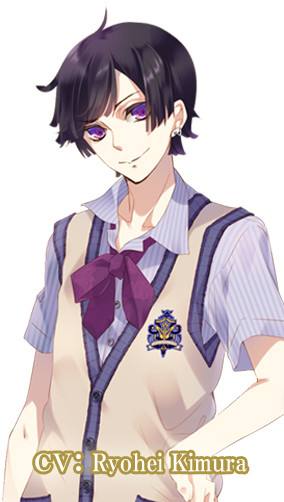
Touma Maizono
Same grade with heroine(user).a model student who is good looking, smart, also good at sports. He was born with gifts, basiclly good at everything. Especially his physical ability is world standard. He once rewarded as attending the world junior dance contest representing Japan.

Kei katsuragi
One grade upper than our heroine(user).famous actor of troupe "kiageha",an honor of the Otori art academy.He's hugely popular not only because of his good looking but also his extraodinary physical ability. His family owns a diner in the countryside, so he's really good at cooking by helping them a lot.

Ryuji Siba
Teacher of the school which our heroine(user) goes to. Also the director of 'kiageha' the school troupe. He was an actor when he's younger, and once a "best-seller" while both good at acting and script writing. He quit the entertainment world for some reason. Started teaching and directing in this school by a friend's connection.
Story
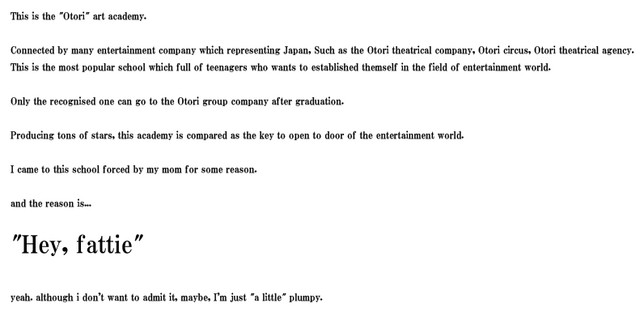
This fall, a new version of the original e "moétivation" tool hit Japan with three bishoujo, your childhood friend, an outspoken tomboy and the school's hot class president/gymnast, now encouraging male otaku to get jogging.
The new smartphone app will plot a course on your 2D surrogate's world, then, as you run, it will use the phone's GPS to show your position relative to the girl running with you and as she voices encouraging comments. Events will unlock based on on your progress.


------
Scott Green is editor and reporter for anime and manga at geek entertainment site Ain't It Cool News. Follow him on Twitter at @aicnanime.
"Tiger & Bunny" x Hello Kitty Collaboration Promotes New Movie
Leading into the February 8th premiere of anime movie Tiger & Bunny: The Rising, the hero anime is teaming up with Sanrio for a line of plushies, clear files, key chains, tote bags, ear phone jacks, mirrors and pass cases with Hello Kitty as Wild Tiger and Barnaby Brooks Jr.
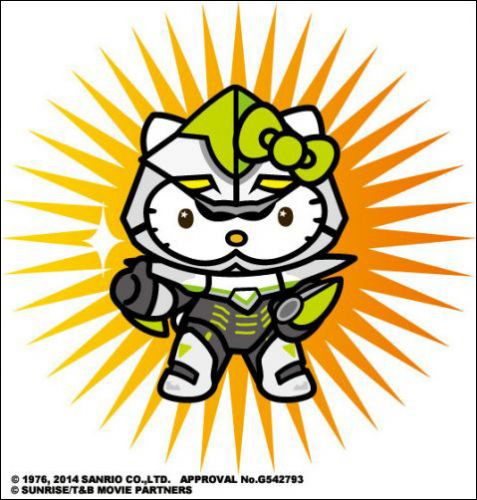
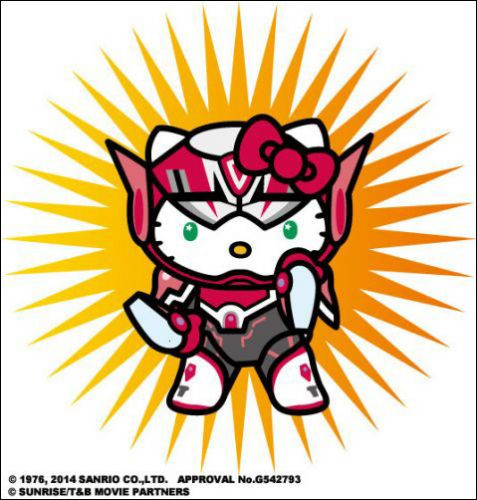
Meanwhile, Dominos has posted more pizza art from their promotion.
まったく。僕を待たせるなんて、ドミノ・ピザさんも罪なことをしますね。でも楽しみはもう少しとっておきましょう。 (C)S/TBM 特設サイト公開中!>> http://t.co/ybqyQPNS12 ※非売品 #tigerbunny pic.twitter.com/4lwS3a8pO8
— ドミノ・ピザ [公式アカウント] (@dominos_JP) January 4, 2014
いよいよ明日からドミノ・ピザでコラボキャンペーンがはじまるぞ!みんな、楽しみにしてくれよな! (C)S/TBM 特設サイト公開中!>> http://t.co/ybqyQPNS12 ※非売品 #tigerbunny pic.twitter.com/gvJJBeeCaN
— ドミノ・ピザ [公式アカウント] (@dominos_JP) January 5, 2014
ねぇ、もうすぐドミノ・ピザとのコラボキャンペーンが始まるじゃない?アタシ、ファイや~ん まちきれないぅあ~ん! (C)S/TBM 特設サイト公開中!>> http://t.co/ybqyQPNS12 ※非売品 #tigerbunny pic.twitter.com/Dswa1IK4xs
— ドミノ・ピザ [公式アカウント] (@dominos_JP) January 3, 2014
------
Scott Green is editor and reporter for anime and manga at geek entertainment site Ain't It Cool News. Follow him on Twitter at @aicnanime.
"Dogs" Kicks Off New Year With Epic Manga Snowball Fight
Shirow Miwa, known his work on the manga Dogs, with the band Supercell, and recently his remarkable Pacific Rim fan art, kicked off 2014 with an epic snowball fight illustrations, slowly Tweeted and expanded over the course of the week.
See the full sized results on his Pixiv page.

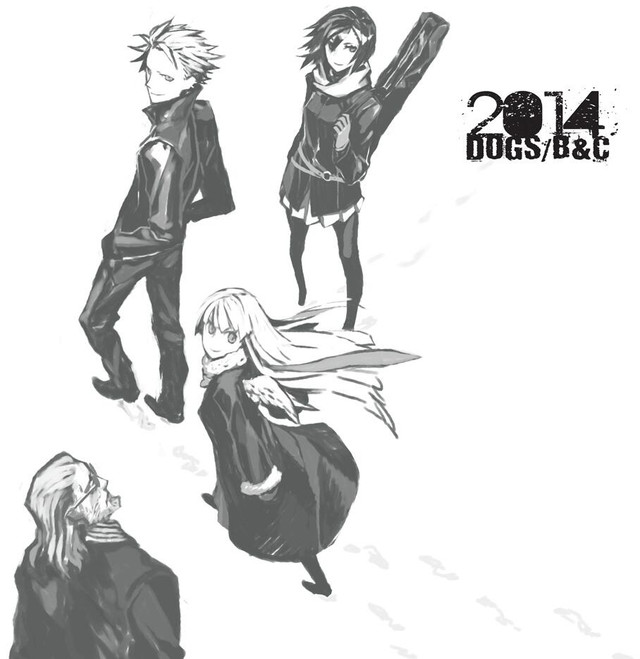
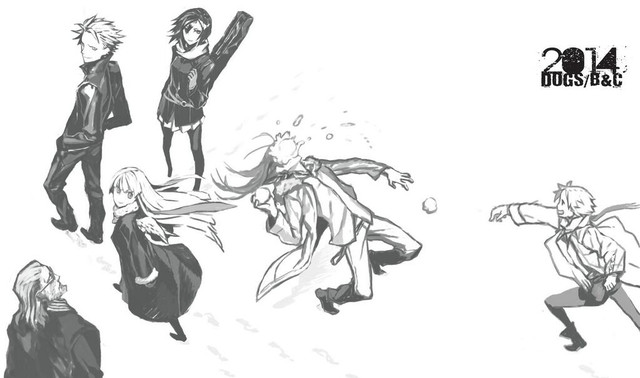
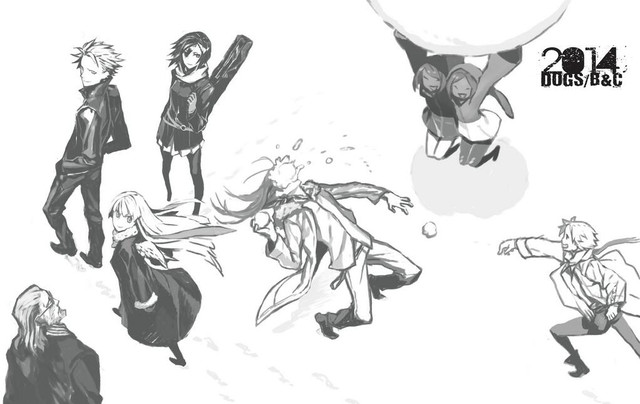
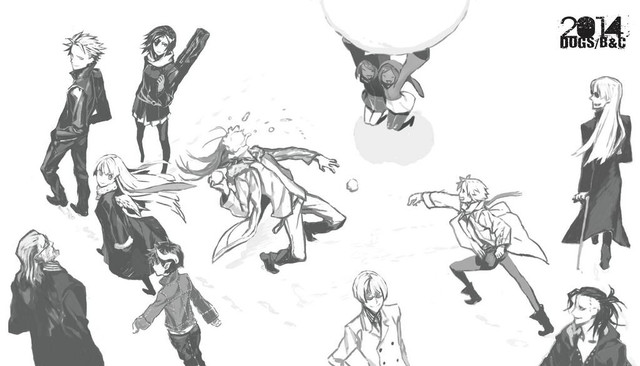
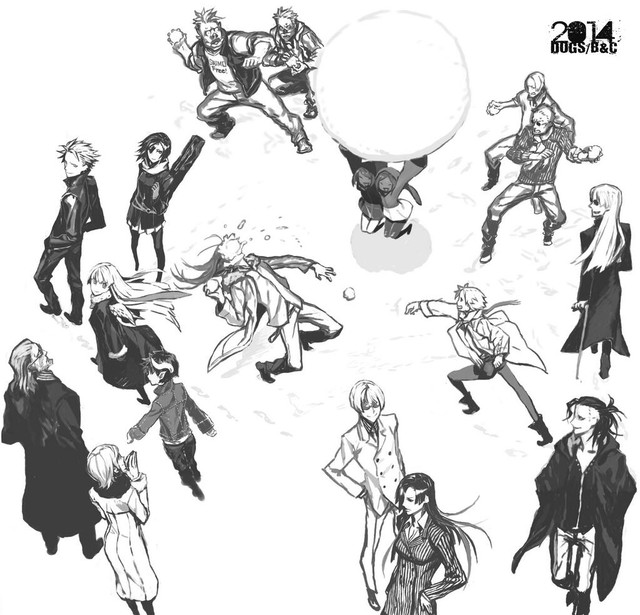

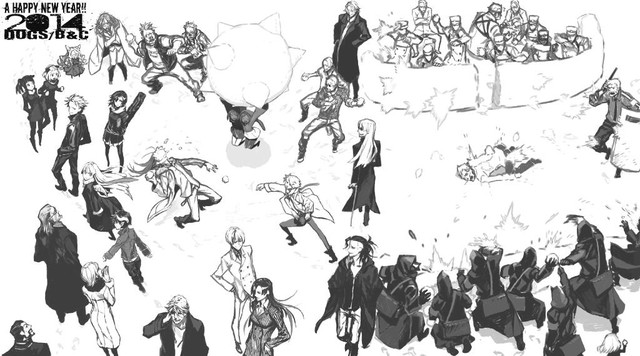
He also did new illustrations of tokusatsu style Pacific Rim
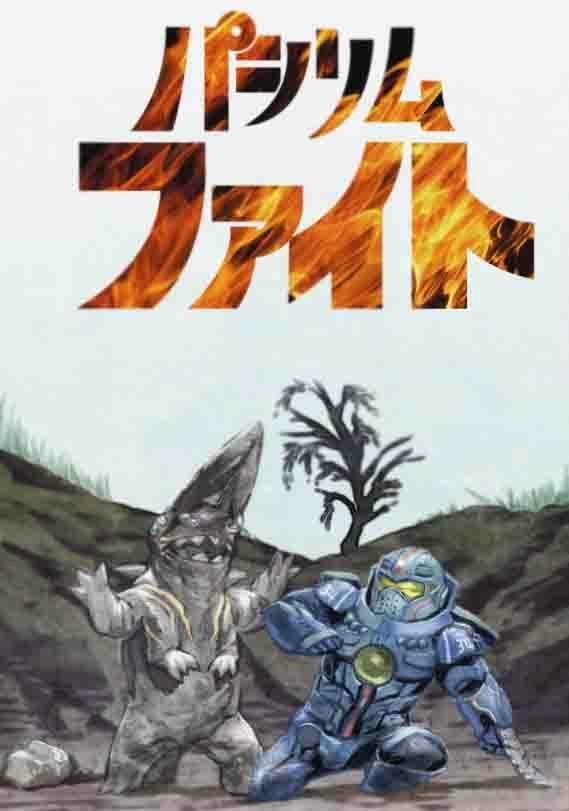
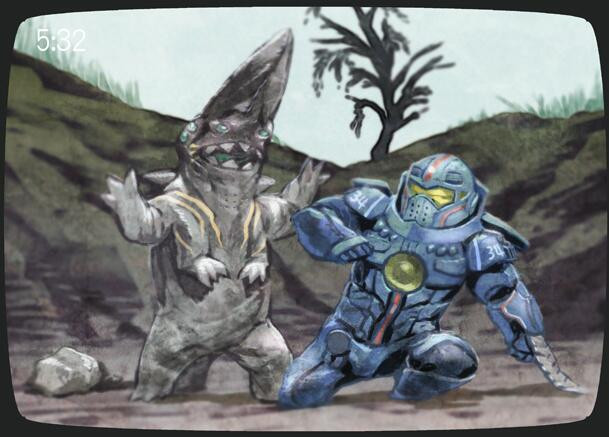
and a Kan Colle style Zubr-class LCAC girl

------
Scott Green is editor and reporter for anime and manga at geek entertainment site Ain't It Cool News. Follow him on Twitter at @aicnanime.
Astro Toy - Nendoroid Colossal Titan And Attack Playset
The first Lego Simpsons set is simply awesome

Behold the very first of Lego Simpsons sets!, as leaked by Eurobricks user Carlos S claims. There are no details about it beyond what we can see on this photo of the box: 2523 pieces, six minifigs including the full Family plus Flanders. It looks fantastically detailed and—apparently—it even opens showing its interior, like some of their other architectural sets.
Cookiemon
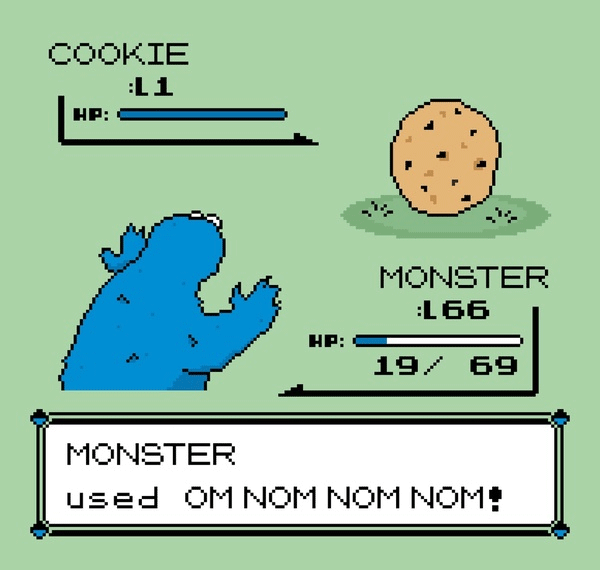
This is cute. I think this is cute. This is actually something that I could probably post in one of my daughters’ rooms, and both they and the wife would appreciate it.
Besides a copy of my Mr. Masters mini-poster hanging in my oldest’s room, I don’t think any artwork I have ever created has been on display anywhere in the house besides my office. And for the record, my oldest swiped one of those mini-posters and hung it up in her room on her own without me knowing. I believe this was back when she was four. Good times…
One Hell of a Journey
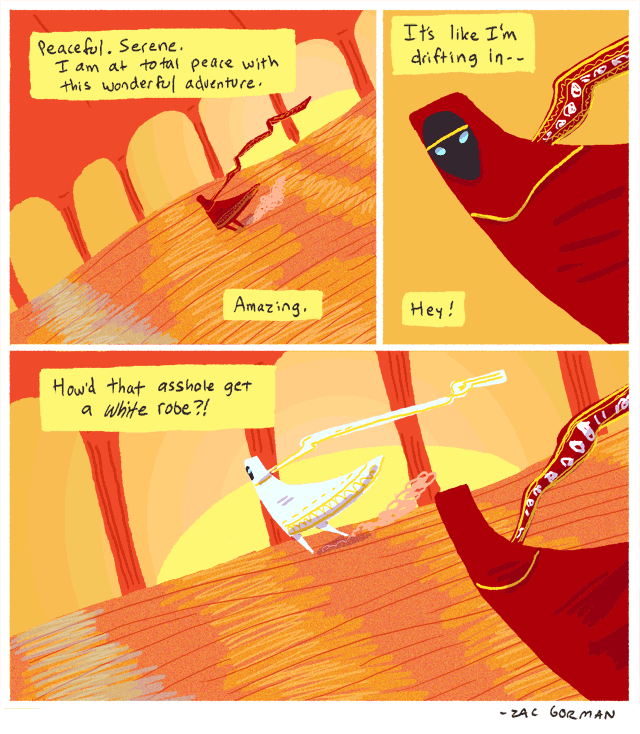
I just realized that I never shared any Journey related content on Dueling Analogs until now. How? Just had to add a brand new tag to the library for it. It’s a shame too. Journey is such a brilliant game.
This comic once again proves, that Zac Gorman has an uncanny ability to tell jokes about games that you may have never even played, but that you can still understand and enjoy.
David Lynch To Shoot New Twin Peaks Material, Probably As A Promo For The Upcoming Blu-Rays
Sorry people of colour, blondes, fellas, the non-attractive (whatever that means), ladies with smaller bosoms, those under 18 or over 27, or anybody with an… um… modern face but David Lynch is looking for a waitress and he’s got a very specific type in mind.
Production is set to take place next Tuesday on a new Twin Peaks promo, directed by Lynch. Here’s the casting call I intercepted:
Hot Caucasian Girl – Brunette or Redheads Only. To play waitress, 18-27. Must have an amazing body, busty, very period looking face.
If you want to submit they want a full body shot as well as a head shot, of course.
Though it’s yet to be confirmed, I’ve heard that the Blu-ray release of Twin Peaks will include the entire series, the prequel movie, a great deal of deleted scenes material – up to 45 minutes have been mentioned, but it’s in the hands of both lawyers and remastering boffins – and it will all hit the street in late March.
Incidentally, if the set lands on March 25th in the US, as I’m expecting, that’s exactly 25 years after Dale Cooper met Laura Palmer in the Black Lodge.
Stay tuned for a lot more. Twin Peaks is just… it’s just… wow. So I’ll be all over news of this release, and the waitress promo while I’m at ait.
David Lynch To Shoot New Twin Peaks Material, Probably As A Promo For The Upcoming Blu-Rays
Mushishi Anime Gets 2nd Season in April
kate:DDDDDDDDDD
Colorful speech bubble lamps light up Montreal street
Stuff I Liked in 2013: Black Is
The thing about the black condition is that it’s exhausting. If it’s not major stuff, like living in fear of police brutality or struggling under the weight of being born behind the eight ball, it’s smaller things, little aggravations like realizing that “ghetto” is a code word or googling to make sure you got a joke right in an essay and accidentally finding a white supremacist site. You gotta keep your guard tight as you bob and weave through your everyday life, and that makes it easy to miss things. You find yourself trying to weather the storm and forgetting about the sunshowers.
As a kid, my knowledge of what Black People Did was limited by my education, my family, my region, and my society. “Black People Don’t” do this, that, and the third. I’m sure you’ve heard a few. Sometimes it’s spoken outright, but a lot of times, it’s an assumption. If I didn’t know that black people were specifically doing something, if there wasn’t some obvious signifier, I’d assume they didn’t. Milestone Media in the ’90s was a revelation because it made it very obvious that black people did, in fact, make comics, and excellent ones at that. Sean Combs and Master P did own record labels. Barack Obama did become president. Spike Lee made movies. There was a wall here before, but it’s gone now. Now it’s become a door. It’s become an option.
In December 2013, cartoonist/animator LeSean Thomas shared this post on tumblr, which featured these images, plus a few more:
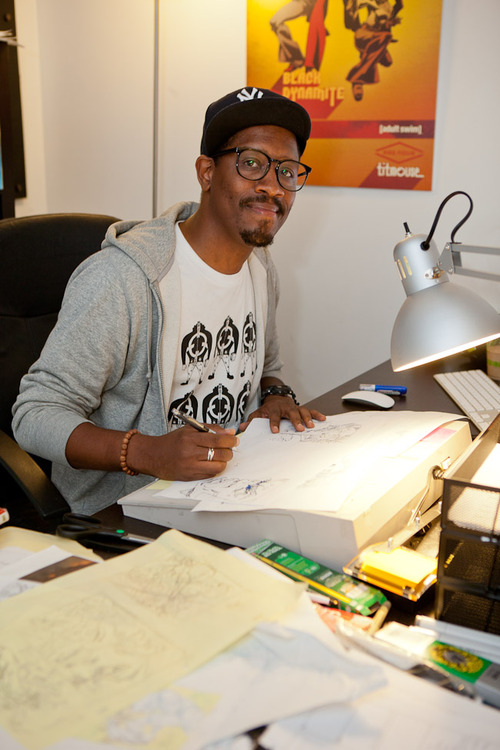
That’s LeSean Thomas himself (in an ill One Piece shirt), Ron Wimberly, and Roni Brown. Thomas is the Creative Producer/Supervising Director of Black Dynamite, Wimberly does character design and layout assists, and Brown is Production Coordinator on the show. There are several more people through the link, too.
Black Dynamite is a brutally funny show, a worthy successor to an excellent movie. It’s a cartoon, a good-looking one, and it airs on a popular channel. As a kid, the thought of a team that was all, a majority, or even partly black probably didn’t even cross my mind. Cartoons were from Japan or Hollywood, and black cartoons were Fat Albert. (Were there more cartoons starring talking cats than blacks?) But this, and The Boondocks, where black people aren’t just on the ship, but guiding it through the waters? Outfitting it with all types of guns and accessories to make it the biggest, baddest ship on the block? It was unimaginable. But it’s beautiful.
As an adult, the tumblr post struck me. I know Ron, Ron’s a friend, but it was more than just “that’s my man doing big things.” It’s bigger. It’s an example, and it’s something that I hadn’t necessarily seen put into one place like that. It’s a reminder that black people do, and do it well.
It’s the flip side to the black condition, the narrative that gets tamped down in favor of slaves and graves. We’ve got rock’n'roll, wild sci-fi tales, ancient civilizations, rap music, soul music, R&B, Richard Pryor, Milestone Media, all types of wild and unbeatable innovations and creations.
I wish I’d had it as a kid, or at least that that idea was easier to access than it was back then. I was talking about this with a few friends the other day, and we were all…not in awe, we’re all grown-ups here, but we definitely felt something warm. “This is good. This is right.” Our news, our culture, delivers a constant stream of misery, condescension, and death, so it’s nice to have reminders that black is, and has always been, more beautiful than I ever realized.Similar Posts:
- LeSean Thomas Signing in LA Tonight!
- When you’re alone and life is making you lonely you can always go -
- Black Future Month ’10
- The Truth is Back
- Puffy is Good, but Milestone Is Forever
'Star Wars' Comics To Officially Move From Dark Horse To Marvel In 2015
It seemed like a foregone conclusion following Disney's $4.05 billion acquisition of Star Wars owners Lucasfilm last year, but Marvel and Dark Horse Comics made it official today: The Star Wars comics franchise will move next year from Dark Horse, which has had the license for 22 years, back to Marvel, which published the first Star Wars comics when the original movies were coming out in the late 1970s and early 1980s.
Everything You Need to Know about Fanime
kateI had no idea this "genre" existed.

As you read this sentence, untold numbers of people around the world are uploading home-made videos to the Internet. Most will soon be forgotten, but some will stick around.
Every so often, the amateur Internet videos that stick around will cluster together and form a genre. The Internet has nurtured a good number of film genres. Some, such as the comedy review videos made by the likes of the Nostalgia Critic, have wide appeal and are accessible to large audiences. Others will definitely require the viewer have a certain frame of mind to be fully appreciated—the YouTube Poop being a classic example.
This post will cover a genre of animation which developed on the pale underbelly of the Net and definitely belongs in the second category. It is known to its viewers as fanime.
Although the term suggests any anime-style animation made by fans, “fanime” has come to refer to a very specific aesthetic. The word is closely associated with shorts made by complete newcomers to animation, often children; these enterprising youngsters, with no access to professional software such as Flash or Toon Boom, make do with a combination of MS Paint and Windows Movie Maker to tell stories inspired by the anime that they watch on television.
Animation made by children is nothing new – countless animators have started out by producing crude cutout or stop-motion films on kitchen tables—but YouTube added a new element. Fanime picked up an actual following, albeit one which arrived only to point and laugh at the crude animation.
Of course, this is another example of the more rotten side of the Internet; few people can defend the public ridicule of a 12-year-old kid’s drawings, after all. This case is unusual, however, as the amateur aesthetic of fanime was ultimately legitimized. People began parodying fanime by making deliberately bad cartoons with the same style – so many, in fact, that fanime became recognized as a full-fledged genre by TV Tropes, that esteemed chronicler of Internet crazes.
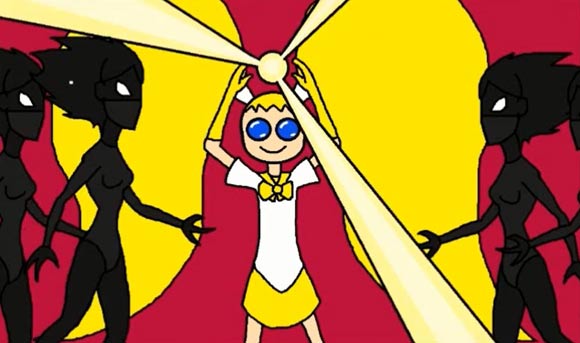
Although a few of these fanime parodies have something resembling conventional comedy writing—Kawaii Schoolgirl has an absurdist sense of humor similar to Adventure Time—most of them simply re-enact stock scenes and imagery from commercial anime, the main twist being that they do it very, very badly. In the process, the much-refined cuteness of anime is transformed into outright grotesquerie.
Amongst the people responsible for this wave of ironic fanime is Anthony W.H., the man behind Quest of Laizen and Tsuki Desu. TV Tropes quotes him as saying that, “The quality itself is not striving to be good or enticing, but is relying on its cheap production values to create a feel of ‘this is so terrible, it’s actually pretty entertaining!’”
As fanime parodists go, Anthony is unusually forthright. There is a strong element of subterfuge to the genre, as the creators of fanime spoofs often intentionally leave their audiences guessing as to whether their cartoons should be treated as jokes or taken at face value. Some will even create false identities to sustain the illusion, as evidenced by the TV Tropes page on a fanime called Prism:
“By the end of the first episode it’s hard to tell whether or not it’s a Stealth Parody of other Fanime, or if it’s really that bad, but considering the first two series by this person, it’s most likely the former… The creator has said his name is Nanako Imatoke, a Japanese female first name with a completely fake last name. He recently uploaded a video of himself revealing he’s black.”
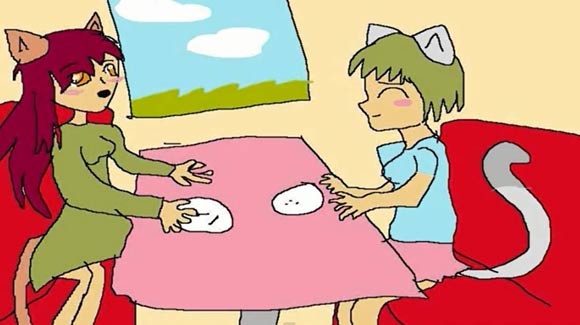
Because of this factor, the parodies have sometimes themselves been parodied. Nyan~ Neko Sugar Girls, which was almost certainly intended as a spoof fanime, became the subject of a YouTube series in which a group of people make sarcastic comments on the animation quality (or lack thereof).
Humor derived from deliberately bad animation can only go so far, and this is why the hoax aspect became such a vital part of the fanime genre. It also places fanime into a continuum of Internet animation that gains its appeal from the element of deception.
Consider the case of the Dead Bart meme. This started out as an anonymous posting by somebody who claimed to have come across a lost episode of The Simpsons, entitled “Dead Bart,” that was deeply disturbing and possibly even cursed; the likely inspiration for this story was the haunted video cassette in Kōji Suzuki’s novel Ring and its subsequent film adaptations.
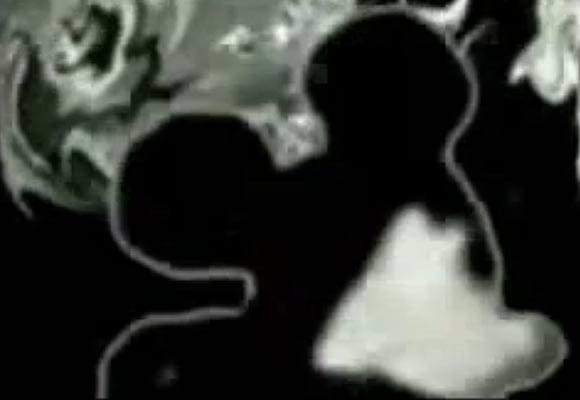
Although the Dead Bart story was clearly fraudulent, it was presented as the truth and went viral across the Internet; a search on YouTube for “Dead Bart” will reveal several efforts at recreating the supposed lost episode using doctored Simpsons footage. This was far from the only attempt to launch an urban legend about a creepy cartoon: Internet hoaxers have also spread rumors about horrific lost episodes of everything from Adventure Time to Naruto, and even entire fictional cartoon series such as Candle Cove and Happy Appy. Closer to home we have the incident in which award-winning independent filmmaker David OReilly made the childlike online series Octocat while pretending to be a 13-year-old named Randy Peters. The Internet is the ideal home for misinformation, and fanime is an example of animators integrating this fact into their work.
Pioneered by children, legitimized by people looking up weird stuff on YouTube, vitalized by online hoaxes, and existing entirely outside any kind of aesthetic considerations, fanime is something that could only have developed on the web. The Internet is a foreign country: they do things differently there.
Image Captions (Top to Bottom)
1. Anthony W.H.’s deliberately awful Tsuki Desu.
2. Kawaii Schoolgirl: Sailor Moon meets Adventure Time… with no budget.
3. Nyan~ Neko Sugar Girls, one of the more infamous fanime parodies.
4. A close cousin to spoof fanime, Suicide Mouse was created for a pseudo-Lovecraftian online hoax about a cursed Mickey Mouse short.
Lego Downton Abbey is bloody brilliant

Eric Stevens built this Lego Downton Abbey set as a Christmas present for his girlfriend (a die-hard fan of the show). He used Lego Digital Designer and spent 15 hours assembling it and customizing the minifigs. Best. Boyfriend. Ever.
Pull Your Team Together for Some Classic Heist Stories!
kate"Locke Lamora’s whole life revolves around heists. As an infamous thief and the leader of a brotherhood called the Gentleman Bastards..." Why have I not read this?

There is nothing quite like a great heist story for pure awesome escapism. You can create a fun and spine-tingling escape sequence, ala The Italian Job or Oceans Eleven. Or, you can be Breaking Bad, and use the format to break the audience’s collective heart. But in the end, they’re just about the teams, and the way all these weird skills like lock-picking, acrobatics, phone phreaking, and Cockney Rhyming Slang can come in handy in tight situations.
With some help from your answers on Twitter, here’s a list of some of the best capers in film, television, and literature!
[We’re pulling you all in for one last job...until the sequels!]
The Italian Job and The Sting

These are the classic, ur-heist movies that set the standards for the list that follows. In each you’ve got charismatic protagonists—Michael Caine’s Charlie Croker and Robert Redford’s Kelly Hooker respectively. You’ve also got truly vile villains, in each case an underworld kingpin whose hatred of the grifter quickly turns personal. The real psychological drama of these films isn’t about the heists themselves—which are intricately plotted and run like clockwork — but rather the protagonist’s own desire to pull off something extraordinary. In The Sting, the tension lies in Kelly’s mounting recklessness, and in The Italian Job, we get a literal cliffhanger and one of the greatest endings in film history.
The Dortmunder novels—Donald E. Westlake
 John Dortmunder stole the motto on his family crest, and he chose well: “Quid lucrum istic mihi est?” (“What’s in it for me?”) is an excellent moral to live by if one is a thief. Dortmunder is a small-time “planner,” arranging heists with teams that are only as large as they have to be, and usually only scoring small amounts of money. Dortmunder’s in his early 40s, his hair is thinning, he almost never smiles, and he has two strikes against him already. But he’s been strong enough to star in 14 novels over the last forty years, so he has that going for him...
John Dortmunder stole the motto on his family crest, and he chose well: “Quid lucrum istic mihi est?” (“What’s in it for me?”) is an excellent moral to live by if one is a thief. Dortmunder is a small-time “planner,” arranging heists with teams that are only as large as they have to be, and usually only scoring small amounts of money. Dortmunder’s in his early 40s, his hair is thinning, he almost never smiles, and he has two strikes against him already. But he’s been strong enough to star in 14 novels over the last forty years, so he has that going for him...
Neuromancer—William Gibson
 William Gibson’s landmark cyberpunk novel is also a heist story. Henry Case is recruited by Molly Millions to steal a ROM module for a mysterious man named Armitage. This caper’s a little different, though, because the module contains some unusual loot: the uploaded consciousness of a cyber-cowboy named McCoy Pauley. The whole theft is engineered so that Armitage can have access to the best possible hacker; I would never advocate a life of crime, but if you’re going to go black hat, doing it to steal someone’s consciousness for hacking purposes has a certain style to it.
William Gibson’s landmark cyberpunk novel is also a heist story. Henry Case is recruited by Molly Millions to steal a ROM module for a mysterious man named Armitage. This caper’s a little different, though, because the module contains some unusual loot: the uploaded consciousness of a cyber-cowboy named McCoy Pauley. The whole theft is engineered so that Armitage can have access to the best possible hacker; I would never advocate a life of crime, but if you’re going to go black hat, doing it to steal someone’s consciousness for hacking purposes has a certain style to it.
The Usual Suspects

Speaking of style... Bryan Singer’s second full-length film with writer Christopher McQuarrie pushed the elegance and verbal acrobatics of the movie so far that it didn’t really matter that the plot itself was pretty flimsy. Here the incredibly convoluted boat heist and loot (which changes from jewelry to heroin to cocaine to money over the course of Verbal’s story) really just serves as a skeleton for sharp writing and hilarious characterizations by Gabriel Byrne, Kevins Pollack and Spacey, and Benicio del Toro. By the end of the film we’re still not sure what actually happened, because Keyser Soze doesn’t really want us to. Some could see this as a flaw, but since this movie gave Singer enough of a name to go on to make the X-Men films, there will be no quibbling here.
Sneakers

Aww, this movie. This movie is so elegant, and so much fun, and it was written by the same guy who wrote Wargames, and Redford and Poitier are impossibly suave, River Phoenix is adorably nerdy, and the words “phone phreaker” and “conspiracy theorist” are used as compliments. Plus, Stephen Tobolowsky is in it! The basic plot centers on a pair of liberal former activists who get together for “one more heist” after twenty years. There’s lots of intrigue about whether one is betraying the other, how much they’ve each reformed, etc., but none of that matters. The important thing is that everyone on Redford’s team would be the nerdy tech guy in a normal movie, and they’re all lauded for being the nerdy tech guy. Not only is the film a solid piece of storytelling, it also celebrates intelligent people who use their wits.
Snatch

Brad Pitt does his funniest work since True Romance, there’s some stuff about trying to track down a stolen diamond, a whole subplot about Irish bare-knuckle boxing, and some Irish Travellers who need to re-home their dahgs. There might be a plot under there somewhere, but does it really matter?
Ocean’s Eleven

It’s not even remotely genre, but this is the remake of the classic-but-not-nearly-as-good Rat Pack movie must be mentioned. George Clooney wanders around Vegas charming people and spontaneously healing them with his smile, while his team—who between them have pretty much every weird niche talent you wanted when you were ten years old—robs his ex-girlfriend’s new boyfriend’s casino. Then there were sequels which gradually diminished the returns, but the films are still notable for making Las Vegas look like the high-class, hedonistic wonderland it has never actually been.
The Lies of Locke Lamora—Scott Lynch
 Locke Lamora’s whole life revolves around heists. As an infamous thief and the leader of a brotherhood called the Gentleman Bastards, he has to stay ahead of the law and, more importantly, the underworld. But when a coup threatens his career, his way of life, and everyone he loves, he has to find a way to outwit the powerful Gray King before he becomes a pawn in a larger game.
Locke Lamora’s whole life revolves around heists. As an infamous thief and the leader of a brotherhood called the Gentleman Bastards, he has to stay ahead of the law and, more importantly, the underworld. But when a coup threatens his career, his way of life, and everyone he loves, he has to find a way to outwit the powerful Gray King before he becomes a pawn in a larger game.
Mistborn: The Final Empire—Brandon Sanderson
 The Mistborn series begins a thousand years into the reign of a Dark Lord who was actually competent enough to vanquish the prophesied Hero. So, with a beginning like that, Sanderson could have gone anywhere, but he decided to graft a caper onto a fantasy structure. In his own words:
The Mistborn series begins a thousand years into the reign of a Dark Lord who was actually competent enough to vanquish the prophesied Hero. So, with a beginning like that, Sanderson could have gone anywhere, but he decided to graft a caper onto a fantasy structure. In his own words:
“I came into this book with two big ideas for the plot. The first was that of a heist story, like Sneakers or Ocean’s Eleven involving a gang of gentlemen thieves who each had a distinctive magic power. I wanted to tell the story of how their different magics and abilities worked together for them to pull an incredible caper.”
Breaking Bad, “Dead Freight”

Oh, Vince Gilligan, why do you hate us so much? Or possibly love us? We don’t even know anymore. “Dead Freight” is a stand-out BB episode, wherein Walt, Jesse, and Todd blockade a train in order to siphon methylamine from its tank. But, this is Breaking Bad, so what begins as a sort of tense and exciting escapade turns into an examination of Walt’s desperation, and ends on a heartless—but necessary?—act. Yay, humanity! Come on, Vince Gilligan! Would it have been so harmful to your vision to give us a Mini Cooper chase through the desert instead?
There was no way to fit everything in this list, so let me know about your own favorite fictional heists in the comments!
“Our Young Saxon Cockerel Here”—The Adventures of Robin Hood

I don’t think I’m going out on a limb saying 1938’s The Adventures of Robin Hood is the iconic version of the Robin Hood mythos. Even 75 years later, if you imagine Robin Hood in your head, you’re probably thinking of a tall, thin man with a goatee, wearing a felt, feathered cap, bright green doublet and tights, laughing haughtily at authority (Or you’re thinking of a fox wearing basically the same clothes, and we’ll get to him next).
And if you think of the archetypal Robin Hood adventures—the quarterstaff fight with Little John; the archery contest; the climactic sword fight on the castle stairs—they’re all in this movie. But for all that it set the ideal of what a Robin Hood story is, The Adventures of Robin Hood has some complicated nuances that really reflect its creation.
[Read More]
The most obvious idiosyncrasy is the brilliant colors. With the success of Snow White and the Seven Dwarfs the year before, studios were eager to show off what they could do with Technicolor. To that end, The Adventures of Robin Hood is full of gorgeous hues: Robin’s bright green outfit, the glowing jewels that line the costumes of Prince John and Lady Marian, the lustrous gold of the goblets and plates. Much of the use of color is pure spectacle, but there is storytelling behind it: contrasting the shiny wealth of the nobles with the dull poverty of the peasants. Additionally, Robin’s forest green costume is actually pretty good camouflage amongst the leaves of Sherwood.
Directors Michael Curtiz and William Keighley set the main Robin Hood versus Prince John plot in the larger context of an ongoing conflict between the native Saxons and the Normans who conquered England only 100 years earlier. The racial nature of the conflict is heavily stated throughout the film: soldiers shout epithets like “Saxon dog”; Norman taverns thrive while Saxon inns are empty and taxed heavily; Sir Guy of Gisbourne tries to shame Lady Marian for betraying “her own Norman people.”
The portrayal of a feasting overclass profiting off the oppression of a racial minority worked as an allegory for Depression era economics in general, Jim Crow laws in the South, and the Nazi rise to power in Germany. (Of course, as Normans and Saxons are both played by white actors, it’s an allegory for racism that fails to feature any people of color.) Into this setting, Curtiz and Keighley place an arrogant, populist bomb-thrower who argues that everyone should be protected equally under the law, and that any king, or would-be king, who does not respect that ideal must be opposed.
The Adventures of Robin Hood really earns that plural in its title because it’s basically two plots in quick succession. In the first, Robin Hood raises an army to resist the oppressive regime of Prince John and Sir Guy of Gisbourne, all while wooing the Lady Marian. When John captures Robin by luring him to an archery contest, Marian leads the Merry Men in a daring rescue of Robin. That’s immediately followed by a second plot where Richard returns to England in secret, and Robin and his men must protect the king from Sir Guy’s assassin before overthrowing John and restoring Richard to the throne.

Robin Hood
Much of the credit for making this Robin Hood THE Robin Hood belongs, of course, to Errol Flynn, that handsome devil. He simply exudes an arrogant charm that’s hard to resist. He’s funny, he’s clever, he’s chivalrous, fearless and joyful. The first time we see Robin, he’s already in full costume, defending a poor hunter from a rich asshole. But it’s the banquet scene that really defines his character.
Robin fights his way into Prince John’s throne to give the prince with a deer, knowing the penalty for poaching is death. Then Robin sits down to eat like he owns the place, disdainful of both John’s authority and military might, all while cheerfully declaring his intention to bring down John’s government. (“You speak treason, my lord.” “Fluently.”) That Robin is correct to be disdainful—as he will escape the soldiers and will destroy John’s power—makes his fearless irreverence charming.
Robin treats everything he does—from getting his ass kicked by Little John and Friar Tuck, to wooing Lady Marian, to dueling Sir Guy to the death—as a fantastic game, which inspires his allies to be cheerful as well, while infuriating his enemies. Even when he’s about to be hung, Robin is a right smug bastard, and we love him for it. You can see echoes of Flynn’s Robin Hood in the more grandiose performances of Ewan McGregor as Obi Wan Kenobi; Kenneth Brannaugh as Gilderoy Lockheart, Zachary Levi as Flynn Rider, and Cary Elwes as Westley.
And, in one great moment, Flynn’s Robin drops the lighthearted act, taking on a serious demeanor when showing Marian the widows and orphans suffering because of Richard’s crusade and John’s harsh taxes. Robin knows there are real consequences for his success or failure, but not for himself.
There’s only a line or two explaining Robin’s backstory—he’s a Saxon lord that turned outlaw to support the poor—but it’s enough to show that he could have lived a comfortable life for himself if he never got involved. The only thing Robin seems to desire for himself is Lady Marian, who he woos relentlessly, but he’s willing to let her stay in the castle after she tells him she can be more helpful to the cause as an insider spy.
That’s hardly to say Flynn’s Robin Hood is a perfect person. He is arrogant, certain of his own righteousness. He never questions whether banditry is the best way of restoring order to England. And he’s vain, determined to prove he’s the best archer in England, even if it means walking into a trap. He’s a bit of bully, as his method of interacting with new people is to verbally or sometimes physically poke them, to see how they fight back. But he also knows when to back off, and never to poke someone who really can’t take it, or doesn’t deserve it.

The Merry Men
Unlike in other Robin Hood films, in The Adventures of Robin Hood there are hundreds of Merry Men, “free born Englishmen, loyal to King Richard,” which makes Robin a real threat to the throne. If the Merry Men were just Robin and few buds, it’s hard to see why John would care about one highway man. But Robin has an army, a highly coordinated one with soldiers that dress just like him, strike at will with intricate, well-planned heists, then disappear; an army with which Robin eventually takes down John and restores Richard to the throne.
Of the named Merry Men, Will Scarlett is there from the beginning, but other than being Robin’s right hand man and understudy, Will’s only defining feature is that he’s a thief who wears bright red in a green forest. So he’s either more arrogant than even Robin Hood, or he’s colorblind. Little John has his moment of glory handily beating Robin at quarterstaves (after Robin intentionally riles him to “see what he’s made of”) then fades into the background as another Merry Man.
Friar Tuck gets a lot more characterization: a fat friar who likes to eat but rails against the greed of the church, a man of peace who’s also one of the great swordsmen of Sherwood, a man of peace who’s quick to anger when teased. He also has actor Eugene Pallette’s distinctive frog-like voice and squat demeanor, making him basically a Lord of the Rings dwarf with a turkey leg.
The Merry Man that stands out the most, who has his own plot line and character arc, is Much the Miller’s Son. He’s the first peasant we see Robin save, and he goes from poor, desperate poacher to empowered soldier in Robin’s army and finally hero of the revolution. He even has a love interest in Lady Marian’s nurse, Bess, and through her is able to stop Sir Guy’s assassin from reaching Richard, allowing the true king to meet up with Robin and eventually return to power. Everything about Much and his plot, including his sobriquet, implies Much is very young, possibly a teenager, but he’s played by Herbert Mundin who was 39 at the time and looks a lot older, leading to a bit of cognitive dissonance.

Marian
Olivia de Havilland makes a lovely Lady Marian Fitzwalter (never Maid, not in this version at least). For the most part, she’s the archetypal damsel in distress, to be wooed and rescued by Robin Hood, and to be lusted over by Robin’s rival, Sir Guy. But Marian also shows a lot of backbone, making her more than just some silly girl.
For one thing, she is not immediately taken by Robin’s good looks and roguish charm. In fact, she pretty much hates him, until she sees all the good he does for the poor, and how much it has cost him to turn outlaw. After that, she’s part of his team, planning Robin’s escape from hanging and then warning the Merry Men that Sir Guy plans to assassinate Richard, even though she’s sentenced to death for that.
Her nurse, Bess, shows even more gumption than that. Bess is the last to surrender to the Merry Men when they capture her, Sir Guy, the Sheriff. And Lady Marian, and she’s quick to flirt with Much, ignoring all class barriers.
Marian and Bess also wear costumer Milo Anderson’s most amazing attempts to take advantage of Technicolor. Marian is always wearing jewel encrusted clothing, shimmering through every scene, and wears what looks like a dress made out of tinfoil for most of the final act. And while Bess is dressed more simply in general, at one point it looks like she’s cosplaying as a tube of lipstick.

The Bad Guys
One distinct feature of The Adventures of Robin Hood is that while both Prince John and the Sheriff of Nottingham are present, the main villain is actually a minor antagonist from Howard Pyle’s The Merry Adventures of Robin Hood, Sir Guy of Gisbourne, played with sneering contempt by Basil Rathbone. Though Sir Guy is left out of many versions of Robin Hood, he makes a lot of sense here. Sir Guy provides the physical threat Prince John cannot, and Flynn and Rathbone’s sword fight at the end is the standard by which all film swashbuckling must be measured. Meanwhile, Guy still has the air of privilege that the lowly, comical Sheriff lacks. If the story is really about the Norman’s systematic oppression of the Saxons, then the villain really needs to be a Norman who benefits from the system.
Not that Prince John, played with smirky smarm by the wonderful Claude Rains, isn’t a great villain himself. He’s hedonistic, rapacious and utterly sure of his power, not really bothering to pretend to care if Richard makes it back from the Crusades unharmed. Unlike Sir Guy, who bristles at Robin’s every word, John chooses to show his contempt for Robin Hood by treating him like a court jester. “Robin, I like you,” he tells Robin after Robin has dropped a deer in front of him. John knows better than to treat Robin as a legitimate rival, choosing instead to regard him as mouse: cute, but ultimately vermin to be exterminated.
Between John and Guy, there isn’t much room for Melville Cooper’s Sheriff to do, other than be comically cowardly and run from most fights.
Richard and the Crusades
The Adventures of Robin Hood has a surprisingly nuanced take on Richard the Lionhearted. Richard is not “the good, true king,” displaced by his scheming brother, and his return does not immediately signal a return to an English golden age. Though Robin declares loyalty to Richard as one of the tenets of the Merry Men, Robin is just using Richard as a symbol, shorthand for the illegitimacy of John’s rule. Robin actually blames Richard for the whole situation, for abandoning his kingdom to go off to the Crusades, and tells Richard himself when Richard and his men return in rainbow colored robes. Chastened by Robin Hood, Richard banishes oppression itself from England on his return to the throne.
Thus, “the Great Crusade” is cast as a bad thing (even if The Adventures of Robin Hood leaves out the racist and religious violence that truly made the Crusades terrible). It also creates an odd parable for 1938. Is The Adventures of Robin Hood a call for isolationism, saying that a country shouldn’t go off to fight a foreign evil (as in, the Nazis), until it fixes its economic and racial conflicts at home? Michael Curtiz will go on to direct Casablanca in a few years, which has the exact opposite message (evil must be opposed, at home and abroad), so who knows?
The Ending
One of the best things about The Adventures of Robin Hood is that it’s the only one (in this series of five) where Robin’s defeat of Prince John and Richard’s return are connected. In other versions, Richard just shows up in time for Robin and Marian’s wedding, which brings up the question of whether Robin actually accomplished anything, or whether he could have just waited out John’s rule.
Here, it’s clear that without Robin’s army of Merry Men, John would have killed Richard and pretended he died on his way home. Thus, Robin’s raid on John has two purposes, it saves a friend (in this case Lady Marian) from being hung, and also restores Richard to throne.
It also gives us one of the greatest sword fights in film history. Rathbone and Flynn really throw themselves into the fight, sweating and swinging and throwing each other around. It makes sword fighting not just look dangerous, but also hard work. And the fight is full of great moment, such as the epic shadows they cast on the walls, and Sir Guy’s sneaky tiny knife. The best moment is when Robin disarms Sir Guy, and instead of accepting Sir Guy’s surrender, or dishonorably executing the villain, Robin kicks the sword back to Sir Guy. It’s a great dick move. He’s going to kill Sir Guy, Robin implies, but he’s going to kill him fairly.
And then it sets the pattern for Robin Hood movies that Robin and Marian run off to have sex as soon as the movie is over.
Drinking Game
This is the iconic Robin Hood movie, and everything you expect to be in a Robin Hood movie is here, so be careful. This is a four drink movie.
In terms of what will kill you, there are a ton of unnecessary spangles, silly hats, hearty laughter, and people saying Robin of Loxley, but really, there is one scene where over thirty Merry Men swing down on vines. If you are drinking every time someone swings on something, your liver will explode.
Fair warning.
Steven Padnick is a freelance writer and editor. By day. You can find more of his writing and funny pictures at padnick.tumblr.com.
“Those Impudent Musical Peasants!”—Disney’s Robin Hood

Disney’s Robin Hood (1973) is the Robin Hood myth at its most mythic. It has the simplest plot (Robin robs and humiliates John so badly that eventually John throws all of Robin’s friends in jail, leading Robin and Little John to stage an epic jailbreak/heist). It’s divorced from historical context, indeed it is divorced from human characters entirely. The Disney version is Robin Hood as fairy tale: John is a lion who taxes his subjects simply because he loves money, and Robin Hood is a clever fox that robs and gives to the poor, because, well, because that’s what Robin Hood does.
[Read More]
It’s nominally set in England, but only a few characters, like Robin and Prince John, speak with British accents. Other characters sound like they come from all over the United States, notably the narrator, Alan-a-Dale (a rooster), voiced by country singer Roger Miller. And of course few of the animals featured are native to England. Drawing on lots of influences—including Disney’s 1967 version of The Jungle Book—the film moves towards a more universal setting. It’s not just one village in one place at one particular historical moment, but every poor village that ever suffered under an oppressive ruler.
There is no nuance to this movie. Unlike in The Adventures of Robin Hood, almost everyone agrees from the beginning that Robin Hood is a hero and John is a bully. There’s one scene where Little John (a bear) asks whether they’re bad guys for stealing, which Robin laughs off by saying they’re merely “borrowing.” And that’s the end of any ethical dilemma. Even the Sheriff of Nottingham (a wolf) and John’s right hand snake, Sir Hiss, get in on the action of making fun of Prince John, “that phony king of England.”
Which brings us to the most striking thing about Disney’s Robin Hood (after it being an animated version where all the characters are animals): it’s unapologetically a musical. Most of the songs are part of Alan-a-Dale’s folk song narration, but Little John’s rousing dance number “The Phony King of England” is a tune so catchy and insulting that John ends up taxing the entire town of Nottingham into debtors prison after he catches Sir Hiss and the Sheriff singing it.

Robin Hood
Brian Bedford’s voice is perfect for Robin Hood. Suave and assured even in the most dire circumstances, and quick to make a joke. He only sounds sad when talking about Maid Marian, whom he lost when he became an outlaw.
Of course, there’s no explanation of why he became an outlaw. We don’t know whether Robin was born noble or common, or if became a thief before or after King Richard left England in the hands of his brother. All we do know is that he grew up with Marian, and that his birth name might in fact be Robin Hood. (He carved their initials in a tree as “R.H. + M.M.” suggesting that her first name is actually “Maid.”)
What we do know is that he shares many of the same traits as the Errol Flynn version: flamboyance, arrogance, generosity, and super flippancy about most things. Even more than Flynn, Bedford’s Robin is explicit about his crimes being “performances” (a word he repeats a few times), and he wears three ridiculous disguises over the course of the film (a female fortune teller, a blind old man, and a young stork archer) to Flynn’s one. It’s all a game to Robin, even the arrow shot though his cap, until his actions get the entire town locked up and his friend Friar Tuck (a badger) almost hanged.

The Merry Men
In Disney’s Robin Hood, it’s not so much the Merry Men as the Merry Man. Robin only has the one official partner in crime: Little John, who’s modeled on—and voiced by the same actor as—Baloo from The Jungle Book. Little John is slightly more cautious than Robin, often warning him not to take risks in challenging Prince John directly, but only slightly. Because he’s just as often quickly running after Robin, getting into his own ridiculous disguise, and acting as back-up knife when Robin gets into trouble.

Other famous Merry Men are in the film, they’re just not actually thieves. Friar Tuck is just a friar, trying to take care of the poor church mice that fill his pews. Alan-a-Dale narrates and sings sad songs when he’s arrested. The role of the young man inspired by Robin Hood is filled by Skippy (a rabbit), plus his sister Sis, his brother Tagalong, and his friend Toby (a turtle). In some ways, the kids are the point of view characters; it’s through Skippy that we learn of Robin and Marian’s backstory, with Skippy that we watch the archery contest, and it’s Skippy, wearing Robin’s hat, who helps Little John drive Robin’s wedding carriage away.
There is no Will Scarlett, unless there was a cardinal in the background I missed.

Marian
Maid Marian may be the weakest part of Disney’s Robin Hood. She’s a vixen, which means Disney never has to deal with the ramifications of cross-species romance. She’s never a damsel in distress, which is good. But she doesn’t really do anything else, either. She loves Robin from the beginning (keeping his wanted poster in her bedroom), and she’s sweet to Skippy and his friends when they barge in on her badminton game. But she never saves Robin, and Robin never saves her, and after having a romantic stroll with Robin around Sherwood Forest to the Oscar nominated song, “Love Goes On” she basically disappears from the narrative.
Her maid, Lady Kluck (a chicken and Scottish, for some reason), is the more active player in the story. Kluck is openly contemptuous of Prince John, taking his role as the villain so Skippy can play the hero, loudly declaring “Long Live King Richard” in range of Prince John’s archers, and charging through John’s soldiers like a wide receiver, all to the tune of the University of Wisconsin’s fight song. But she, too, disappears from the climax only to reappear right at the end.

The Bad Guys
Sir Peter Ustinov’s Prince John is the source of most of the humor of the movie. His motives may be simple (he loves money, and sleeps in the treasury), but his characterization is actually complex. He’s a lion, because his brother Richard is obviously a lion, but he’s a scrawny lion, wearing his older brother’s clothes that are way too big for him. He’s a baby who sucks his thumb and calls for his mother when things go poorly. He’s also vain but he’s insecure. He’s vicious, but a coward. He’s suspicious, but of all the wrong people. He’s basically a clown.
Sir Hiss takes the role of Sir Guy, the noble suck up to the Prince. Sir Hiss has an odd multifaceted relationship with John, as he’s John’s minister of finance, best friend, and pet. He literally sleeps at the foot of John’s bed and his tongue tickles John in his sleep. He’s also the most fantastic, “cartoony” character in the movie. Not only can he hypnotize people (like his character model, Kaa), he can also float away in a balloon he himself blew up, and use his tail as a propeller.
With John and Hiss as comic relief, that leaves it to the Sheriff to be the actual threat. He’s a wolf, but he’s bigger than even Little John. When he comes knocking on peasants’ doors looking for taxes, he’s immediately threatening. He also has the high pitched, Alabama accent of Pat Buttram, famous for being Mr. Haney on Green Acres, which again moves the setting from the specific Nottingham of the late 12th century to any town, anywhere.

Richard and the Crusades
King Richard and the Crusades are barely mentioned in the film, only enough to explain that John isn’t really the king. The opening exposition and Little John’s song call it a “great crusade,” but we learn that Sir Hiss actually hypnotized Richard into going on what Prince John calls a “crazy crusade.” Again, without getting into the details of exactly what Richard did on his crusade, the crusade is presented as a bad thing which took the rightful ruler out of the country.

The Ending
Disney’s Robin Hood decides to one-up The Adventures of Robin Hood by having Robin save Friar Tuck and the entire town of Nottingham from jail. While ALSO emptying John’s treasury of coins, which, again, is John’s bedroom. That seems like an unnecessary risk to me (it wakes John), but then I’m not Robin Hood, so what do I know.
After that, it ups The Adventures of Robin Hood by staging the climactic sword fight (or sword and chair fight) in a flaming tower. It’s here that the Sheriff becomes truly monstrous, bursting through charred doors and towering over the now very small Robin Hood. It’s a rousing action sequence that ends with Robin leaping to his seeming death to escape.
Which is my second problem with the film (after Marian’s unimportance): it kind of just ends. Robin escapes unhurt, much to the relief of Little John and Skippy, but he leaves John in power. Penniless, but in power. There’s nothing to stop John from re-arresting all of the escaped villagers, or taxing them into oblivion again. Except Richard just shows up in the next scene and John’s in prison, so Robin and Marian can get married and apparently do it right there in their wedding carriage (at least, that’s the implication as they pull down the shades).
There’s an unfinished alternate ending (which you can find on the DVD) where Robin IS injured escaping from John, and Marian and Little John have to care for and hide Robin. Prince John himself finds Robin and is about to kill him when Richard appears and personally saves Robin and arrests his brother. That would have given Marian something to do in the last act and tied Richard’s return to Robin’s jailbreak. But apparently that ending was deemed too dark, so the cleaner, quicker version was released instead.
Drinking Game
Warning, this is four drink movie. It’s short and it looks like it’s going to be a two drink movie at most going in to the jailbreak sequence. But then Robin starts emptying out John’s treasury, which is nothing but bags of gold. So if you’re drinking every time someone handles a bag of gold, you will die.
Steven Padnick is a freelance writer and editor. By day. You can find more of his writing and funny pictures at padnick.tumblr.com.
14 for '14: Comic Book Creators To Watch In The New Year
2014 promises to bring a flood of amazing work from a raft of talented cover artists, writers, web cartoonists, interior artists and mangaka. ComicsAlliance has looked at the new projects on the horizon and made a pick of 14 comic creators who we think will make an impact in 2014. Our hope is that this is just the tip of the iceberg, that there are 140 amazing creators on the cusp of creating something great in 2014 -- but these are our picks of the creators to keep an eye on.
Nathan Fillion Poses Sexily With His PS4 Like a Big Ol’ Fake Geek Boy
Dear PS4,
Last night was dope.
http://t.co/f9IrqBSrPQ
— Nathan Fillion (@NathanFillion) December 21, 2013
DISCLAIMER: Calling Nathan Fillion a “fake geek boy” is a joke. It is impossible to be a fake nerd. As with the Fake Nerd Boys tumblr, the headline of this post is a satirical swipe at the way women in nerd/geek spaces are disproportionately judged based on their physical appearance compared to men. See: The “Fake Geek Girl” myth.
Get it? Got it? Good. If I catch any flak for calling someone a fake nerd, I swear to the Force….
(via: Geeks Are Sexy)
Are you following The Mary Sue on Twitter, Facebook, Tumblr, Pinterest, & Google +?


















